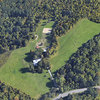VCSD adopts scaled-back $2.7M plan
— Photo from the Voorheesville School District website
"Having a solid roof is fundamental," said the Voorheesville superintendent, Teresa Thayer Snyder, noting the current high school roof was installed 30 years ago and now leaks badly with barrels being used in the building to catch rain water. The lion's share of the district's proposed capital project, about $2.3 million out of $2.7 million, is for a new roof.
NEW SCOTLAND — The Voorheesville Board of Education has decided not to endorse a proposed $11.5 million capital project and instead adopted a $2.7 million plan to fund the district’s top priorities, including a new high school roof and technology upgrades needed to meet online state testing and evaluation requirements.
Some members of the board, including President Timothy Blow, characterized the initial $11.5 million proposal as a “wish list.”
Speaking to The Enterprise, Assistant Superintendent for Business Gregory Diefenbach added to that sentiment, by saying, “What’s going to happen is we have this whole $11 million plan of everything we’d like to do. We sat down financially and asked, ‘Can we really absorb this?’ It was a pretty easy decision we couldn’t, so we rolled back and said, ‘OK, what are the things we really need to do in the next year?’”
On Monday, the school board unanimously voted to approve spending $555,000 from the district’s building reserves to help fund the adopted $2.7 million project. About 61.8 percent of the remaining $2,147,700 will be paid with state building aid, leaving the rest, approximately $820,000, to be raised through local taxes.
Under the adopted $2.7 million plan a $250,000 property owner would see a monthly tax increase of about $1.40 for New Scotland residents, $1.53 for Guilderland residents, and $2.10 for Berne residents. The bond for the new proposal would be for 15 years, five years shorter than the previous plan.
A voter referendum on the proposal will be held on Dec. 17.
Comparatively, under the initially proposed $11.5 million plan, Diefenbach told the board, a district property owner with a $250,000 home would have paid an average of $13.13 more a month in school taxes for the next 20 years.
Leaking roof and state mandates
“Everything highlighted in the first plan was desirable but we decided it wasn’t the right time for the district to indebt ourselves,” said Superintendent Teresa Thayer Snyder.
“Having a solid roof is fundamental. This roof has outlived its usefulness and for a long while we’ve known it’s not in the best interest of the district to keep letting it go,” she said.
The superintendent said the current roof on the high school building was installed 30 years ago and had a warranty for 10 years. In 1995, the school paid a contracting company about $600,000 to resurface the roof but its condition has continued to deteriorate, said Snyder. She said water was leaking inside the building, causing an escalating problem of internal water damage, and it was common for buckets to be placed in some areas during storms to catch leaks.
“It is leaking badly. There are a lot of barrels in the building catching water when it rains. There’s possible water damage inside the ceiling. I have a leak in my office that comes down and actually starts in the principal’s office,” Snyder said.
The school hired an engineering firm to assess the roof about a year ago after a heavy rain caused substantial leaks. An infrared scan revealed moisture was present in large parts of the ceiling and roof that were supposed to be dry.
The roof replacement, estimated to cost about $2,345,000, represents the lion’s share of the proposed $2.7 million project. Another $78,000 will be spent on repairs to masonry relating to the roof. The remaining funds, about $279,000, will be spent on upgrading networks and wireless access technology.
Snyder said the district needs to update its computer infrastructure so it could comply with new state mandates requiring it be connected to state databases for online testing and evaluations.
The top of a larger plan
The adopted $2.7 million project was once part of the initially proposed $11.5 million project. The roof replacement and technology upgrades were listed among the district’s top “phase one” priorities in the plan.
Other high priority projects include replacing boilers at each of the schools and installing security systems — including cameras at each. The total cost of approving all priority one projects is estimated to be about $6,607,900.
The board has discussed the possibility of proposing other building plans that would include the remaining phase one projects.
Diefenbach said the first task would be getting voter approval for the currently proposed project.
“In the coming years, we’ll revisit the list,” he said.
Diefenbach said the district’s debt from past building projects would decrease significantly by 2021.
“We want to make sure new debt doesn't impact us until that falls,” he said.
If voters approve the project, the district plans to begin and finish roof construction between July and August in 2014, when students will be on summer break. The technology upgrades are scheduled for completion before January 2015.


